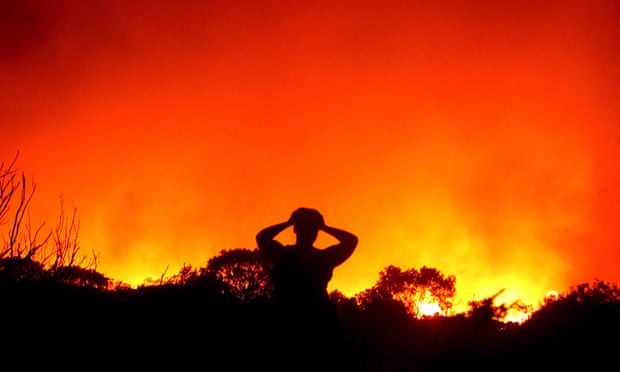
The white population has fled, government has all but vanished … First published in Afrikaans a decade ago, this post-apocalyptic successor to Heart of Darkness excavates the traumas of a nation
Trencherman, first published a decade ago in Afrikaans and now available for the first time in Britain, imagines a post-apocalyptic South Africa plunged into crisis by the explosion of the Koeberg Nuclear Power Station and the almost total emigration of the country’s white population. Overtly writing back to Conrad’s Heart of Darkness, Eben Venter depicts the once hopeful Rainbow Nation transformed into a feudal society run by criminal syndicates and blighted by child trafficking. Police are corrupt and central government has all but vanished.
The novel’s narrator, Martin Jasper Louw, known as Marlouw, is – like Venter – an Afrikaner expat in Australia. His sister, Heleen, pleads with him to return to the family’s former Eastern Cape farm, Ouplaas (Old Farm), where her adult son, Koert, now lives. After their parents’ death, Marlouw had convinced Heleen that she should sign the farm over to the families who worked the land as compensation for generations of inequality.
On his return to South Africa, Marlouw is warned that Koert, like Conrad’s Kurtz, has become a strongman, the distributor not of ivory but of dwindling supplies of mutton raised on the failing farm. Marlouw finds Ouplaas denuded of trees – fuel is a constant worry in the absence of electricity – and the house divided into sections allocated to the worker families, while Koert and his Aids-ravaged girlfriend, Esmie Phumzile, remain sequestered in their own private area.
Sign up to our Bookmarks newsletter
Read more
It is the mystery of Koert’s power over these people that drives Venter’s story. Although valued by the farm’s new owners, who rely on him as enforcer and patron, Koert is also a parasite, destroying the lives of everyone around him. Initially prevented by Esmie and the others from seeing his nephew, Marlouw is distressed to find that old ways of relating quickly resurface: “My presence has opened up the past. I represent the bad old days … the oubaas strides across the werf with his kierie and hat. He thinks to himself: a boer doesn’t work with his hands.”
When Koert finally appears, late in the novel, it is impossible not to see the spectre of Marlon Brando’s Kurtz in Apocalypse Now, particularly in Marlouw’s shock at Koert’s physical transformation, the “beautiful” whiteness of his rower’s biceps lost to a hideous cascade of larval fat. Koert’s Afrikaans is as despoiled as his beauty: in place of the taal, or language, celebrated by apartheid-era Afrikanerdom, Koert speaks a melange of German, Dutch, archaic English, Afrikaans, isiXhosa and township slang in Luke Stubbs’s translation. A mad oracle foretelling the end of his people on the land, he warns Marlouw:
“Your lot’s language that you shaped … and propped up so. What for? For nothing. Snot brudder of mine, let Koert truth-say for you: I am he, I am the taal, the volk, I am your destiny, your fear, das Ende des Lebens … the very heart of darkness who has remained.”
In Marlouw’s humbling dependence on a community of black South Africans, we might hear an echo of Maureen Smales’s experience in Nadine Gordimer’s July’s People, also a speculative fiction about a future South Africa thrown into civil war. And there is also something of JM Coetzee’s Cape dystopia, Life & Times of Michael K. Marlouw, like K, tries to find meaning amid the chaos by planting pumpkin seeds in earth that promises little generative hope.
Advertisement
Futurity is among the novel’s primary concerns. Marlouw and Koert, both childless, become horribly distorted mirrors of each other; where Marlouw has a club foot, Koert has a gangrenous one. In a bravura speech of megalomaniac delusion, Koert notes that the women of South Africa are worst affected by Aids and wonders what it will mean if no one is left to bear children.
Now, 10 years after its first publication, Trencherman can be read as one of the foundational texts of post-1994 South African speculative fiction, alongside Lauren Beukes’s Moxyland and Zoo City, and Henrietta Rose-Innes’s Nineveh and Green Lion. Venter’s novel, however, is working in a palpably different tradition, one in which those speculative energies are not global or even continental, but specific to South Africa, the dystopian nightmare framed as an effect of that country’s historical traumas and the real shortcomings of its democratic present.
If there is light in Marlouw’s journey into darkness, it is perhaps in his refusal to presume he could ever right all that has gone wrong. Venter resists easy answers, convinced, it seems, of the intractable complexities of South African society now, and the difficulty of overcoming the horrors of its past.
• Patrick Flanery’s I Am No One is published by Atlantic
No comments:
Post a Comment